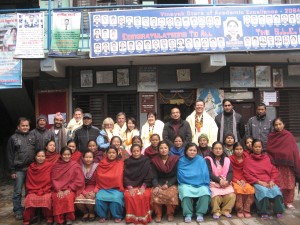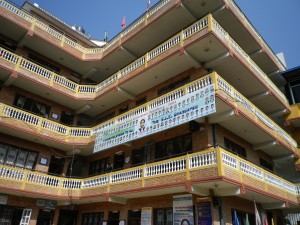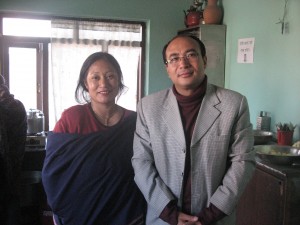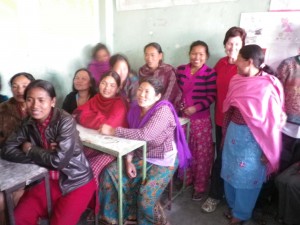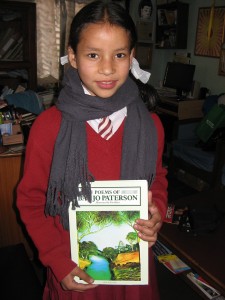NAFA Child Education Sponsorship Program
Vinayak Shiksha Niketan Secondary School, Thimi, Nepal
- Researchers: Rachel Gehrke, Kate Miller, Nghi Vuong
- Interpreter: Ramita Shrestha
- Supervisors: Dr Petra Kohts, Dr Deborah Setterlund
- Written by: Dr Deborah Setterlund
- Special thanks to Surendra Prajapati, Helen Zada and Rod Setterlund for statistical information
Date: April 2012
Copyright held by The University of Queensland. Not for reproduction without permission of author Dr Deborah Setterlund, School of Social Work and Human Services, U of Q, St Lucia.
EXECUTIVE SUMMARY
1. In 2003 NAFA commenced a child education sponsorship program at Vinayak Shiksha Niketan (VSN) English Secondary School in Thimi, Bhaktapur.
2. The aim of the sponsorship program is to provide a basic education for disadvantaged children at VSN School or Creative Learning Academy (CLA) in Thimi.
3. A systematic evaluation of the sponsorship program was conducted in Nov-Dec 2010 and January 2011 by three University of Queensland social work students undertaking field work in Nepal with NAFA and Joy Foundation.
4. Information was sought from 5 key participant groups: VSN Principal, 6 VSN teachers, 2 groups of parents (6 parents working in a carpet factory in Thimi and 5 non-carpet factory parents), and 5 older sponsored students.
5. A total of $120,000AUD has been allocated by NAFA to the education sponsorship program since 2003.
6. Successful management of the sponsorship program is administratively time consuming. The NAFA president reports that the sponsorship programs (Thimi and PA Nepal), together with the Further Education and Training (FEAT) program, create the most administrative work of any NAFA project.
7. A total of 86 students are benefitting, or have benefitted, from the sponsorship program since inception. Of these, 64 are currently being supported in classes 1 – 10; 2 are in class 11 & 12; 10 are continuing their education post grade 12 through the FEAT program; 3 students completed their SLC under NAFA sponsorship, then left the program; and 7 exited the program before reaching SLC level.
8. To date, all 15 sponsored students who have reached grade 10 sat the SLC exam and all achieved a pass, and some achieved results in the top division.
9. The sponsorship program targets poorer children in the community, with 39% of children supported from Nursery to Grade 10 coming from families of carpet factory workers. The gender balance in favour of girls (69%) is appropriate, given the low level of literacy of women in Nepal.
10. Surendra reports that all sponsored students attend school regularly and are very diligent in their studies.
11. Annual reports of individual students’ academic results show that all students are passing successfully and in some cases are achieving excellent results.
12. Overall, the key participant groups report a high level of satisfaction with the program.
13. A key benefit identified by parents is the opportunity for their child to gain a high quality education, which they could not otherwise afford. Education is synonymous with a brighter future.
14. Parents from the carpet factory report that the sponsorship of their children reduced their worry about the cost of living and enabled them to focus on daily survival such as buying food.
15. Parents from the carpet factory raised a number of concerns regarding: the continuation of the sponsorship program, the conditions of the sponsorship (such as sponsorship being conditional on continuing to work in the carpet factory); and the role of the sponsor.
16. In January 2011, NAFA members in Nepal at that time responded immediately to some of the concerns expressed by parents, by meeting with both groups of parents.
17. Overall, both the quantitative and qualitative data from all key participant groups strongly indicate that the VSN education sponsorship program is achieving the aim of providing disadvantaged children with a basic education to grade 10, with a cost of between $300 and $500 per student per year.
18. There are a number of recommendations arising from the evaluation. One recommendation concerns the sustainability of the sponsorship program:
- Given the administrative demands of the program, can NAFA sustain the administrative load in the coming years?
- Should the numbers of students sponsored be capped in light of the administrative load and the number of children coming through who could apply for FEAT funding? The current policy is that a new student is accepted into the VSN program when a child leaves the PA Nepal sponsorship program.
- At the present time a child who enters the sponsorship program at nursery level will require 13 years of schooling to reach SLC level. Should NAFA have an older age criteria for any new children coming into the program?
- Does it matter if the program were to decline or fold before all current and new children complete SLC, keeping in mind that fear of losing the sponsorship is a key concern for a number of parents. On the other hand, it can be argued that some years of quality schooling is better than none.
Full report available from Dr D Setterlund

